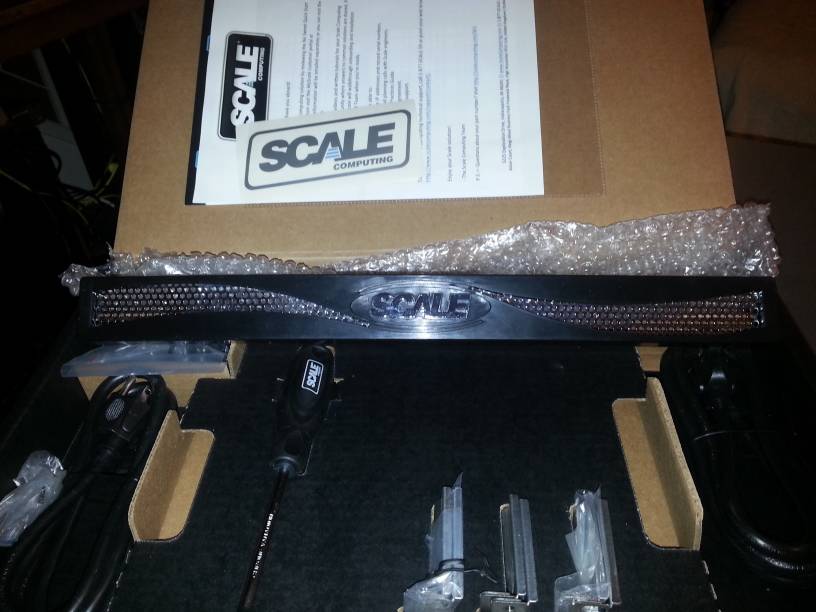This article is more than 1 year old
Scale Computing: Not for enterprise, but that's all part of the plan
Four months of use have made the Scales fall from my eyes
Performance
The three HC1000 nodes delivered are previous generation quad-core E3 Xeons with 32GB of RAM each and 4 x 10,000 RPM SAS drives. Each node has 4 1GbE NICs. Scale tends to sell more of the other models than it does the HC1000s, but I find it great to test things with the lowest available option, as it gives me an understanding of what the entry level is like. That matters to SMBs.
Gauging and discussing performance is hard. From a hardware standpoint these are some pretty wimpy nodes. The Neon server in my lab could eat a dozen of those and still have performance to spare.
I got the lowest tier units out of the refurb pile. It's not fair to compare these to some completely ridiculous monstrosity. The only fair test is a like for like against similarly specced units running other hypervisors.
It just so happens that I have a customer with 3 very similar nodes. The HC1000s are Supermicro boxes under the hood (Scale uses Dell for their larger nodes) and I am pretty sure that if there's a difference between the Supermicro nodes I selected for comparison and the Scale nodes they're minor motherboard artefacts.
I'm not going to bore you with numbers, as benchmarking is pretty meaningless in this scenario. What I did note was the following:
Scale's hyper-converged approach costs about 4% of a 2.6Ghz 4-core Xeon v2's CPU power when compared to KVM nodes using iSCSI.
Scale was actually faster than a VMware ESXi + VSAN in more runs than it was slower. The differences were marginal enough to call it a tie.
Scale crushed Hyper-V like a bug. I don't have a three-node, hyper-converged solution for Hyper-V, so I used a three-node Hyper-V iSCSI set-up (with 12 10,000 RPM drives in RAID 6 in the iSCSI array) for testing. Scale migrated workloads faster, delivered about 15% more IOPS and was able to deliver 20% more CPU to the VMs.
I am not sure why the Hyper-V test turned out the way it did. Hyper-V shouldn't perform this badly against KVM. I was using CentOS 6 VMs for testing, and had the relevant virtual tools loaded for all platforms.
Test after test, I came to the conclusion that KVM is not an inferior hypervisor to VMware or Hyper-V. It performs as well or better in almost every test I could come up with. Scale's hyper-converged extensions to KVM – which are just a couple of extra modules, in order to keep ongoing maintenance simple – don't seem to add a lot of overhead.
Put simply: there are no performance reasons not to choose a KVM-based hyper-converged solution over any of the competing hypervisors or storage types. I'll be honest when I say that result surprised me. I always thought of KVM as the poor country cousin of hypervisors, but I was clearly wrong.
Datacenter Butler
I've been through two code updates with scale and one dead hard drive replacement. How Scale deals with this is entirely different from how other SMB vendors I've worked with approach things, and more in line with how enterprise vendors used to behave – and how some still do, if you pay enough money.
Not long after the nodes went up I got an e-mail from a Scale support tech informing me that a hard drive had died. I was intrigued and concerned. I hadn't set up any monitoring on the nodes yet, so I missed the dead drive event, but I was a little concerned that my shiny new hyper-converged appliance was calling home without my knowledge.
After some discussion with Scale's CTO I got an idea of what kinds of information the nodes send back to the mothership. They basically send alerts and some usage statistics, nothing that makes me anxious, and I'm the poster child for not wanting any of my data sent to the USA.
Software updates were handled in a similar fashion. An e-mail arrived in my inbox informing me that there was a new version available and would I please enter the code from that e-mail into the support section of the Scale UI. This causes the Scale cluster to open a VPN tunnel back to Scale HQ, and the Scale support staff perform a completely interruption-free update for you. You get an e-mail when it's all done.
If you prefer to do it all yourself, there is of course the option in the interface to do so. Updates are straightforward and workloads are easily migrated from one node to another in order to do updates in sequence.
Again, consider for a moment Scale's target market. SMBs are lucky if they have an IT guy at all, let alone one who is going to keep on top of everything. Scale are shipping a turnkey hyper-converged appliance with the full white glove treatment for so far below the major enterprise vendors I'm honestly shocked one of the majors hasn't bought them out just to kill them off.

